22 Top Exterior House Styles Ideas to Boost Your Home’s Curb Appeal
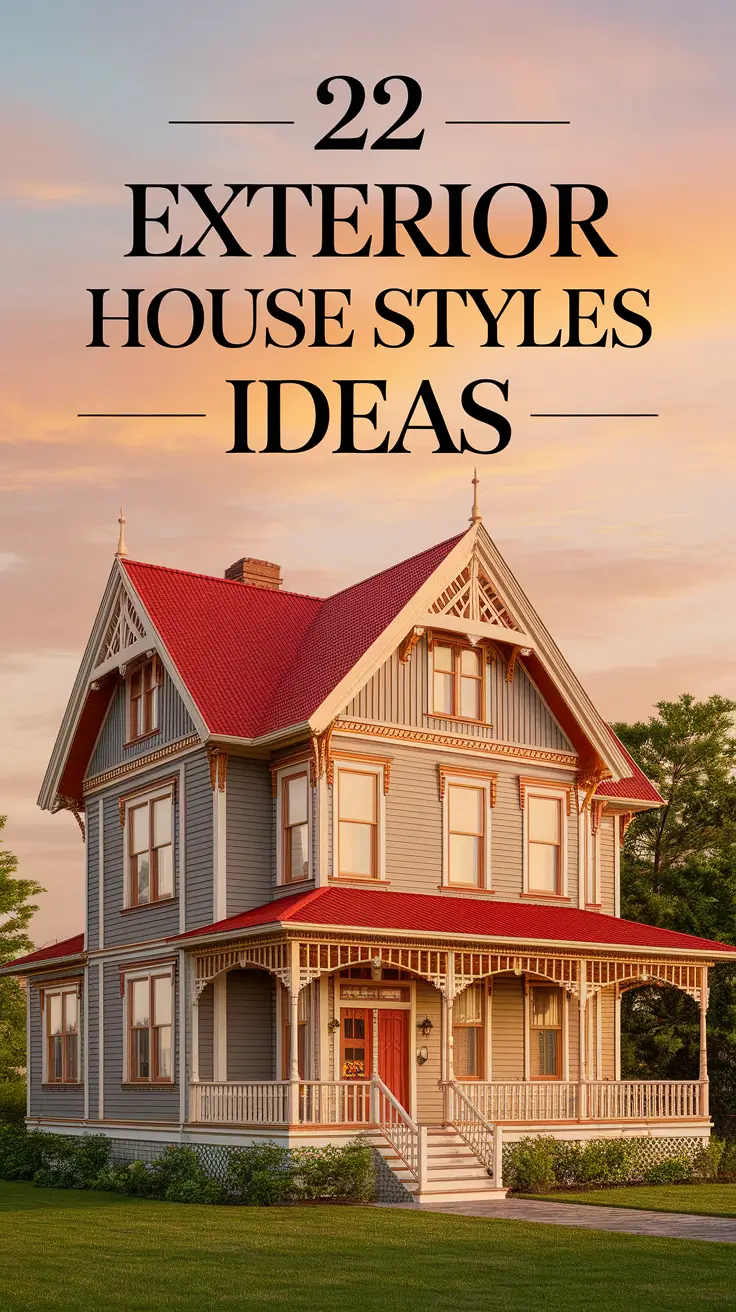
Have you ever passed by a house and been completely drawn to its outside? How do exterior house designs so easily show off charm, luxury or timelessness? In this article, I’ll share with you some of the best and most popular design choices homeowners are making in the U.S., including modern exteriors, farmhouse style, colonial looks and more. Whether you’re renovating, building, or just dreaming, we’ll dive into real-world elements that define these styles—color, form, structure, big windows, stucco, and more—so you can visualize the perfect exterior transformation. Let’s find out why each design is attractive, practical and built to last.
Classic Curb Appeal: Traditional Exterior House Styles
To me, traditional exterior house styles are those that have been around for a long time. Often, these homes use brick or stone, have evenly arranged windows and have a classic roof design. It’s all about making sure things are not too fancy, but that everything is where it should be. When these homes are lit with traditional uplighting on the exterior, they often seem warm and welcoming, highlighting the building’s shape and interesting surfaces.
The usual features are shuttered windows, gabled roofs and large front porches supported by columns. Most likely, you’ll notice wood-framed doors, intricate molding, iron railings and evenly arranged flower beds. The choices made in these designs give families a look they can enjoy for years, as well as something beautiful to look at.
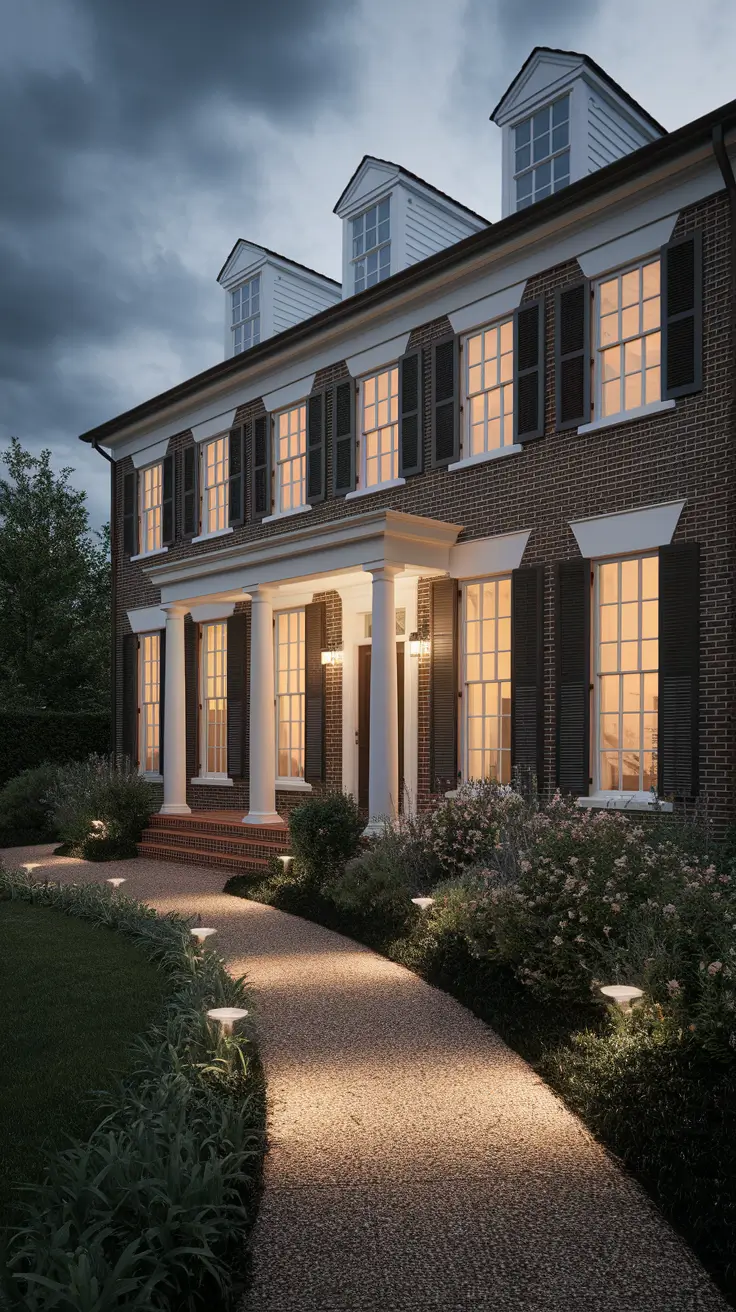
I often notice how traditional styles look great in suburban areas or neighborhoods that have been around for a while. According to Architectural Digest, there’s still a strong interest in traditional homes, even as modern ones become more popular; the difference is that timeless elements are now used with today’s energy and material requirements. What I’ve noticed in renovation projects across New England is the same.
To elevate this section, I would suggest mentioning exterior paint palettes (like eggshell white with navy accents or Revere Pewter) and complementary lighting design. The authenticity of the style is greatly improved by these small details.
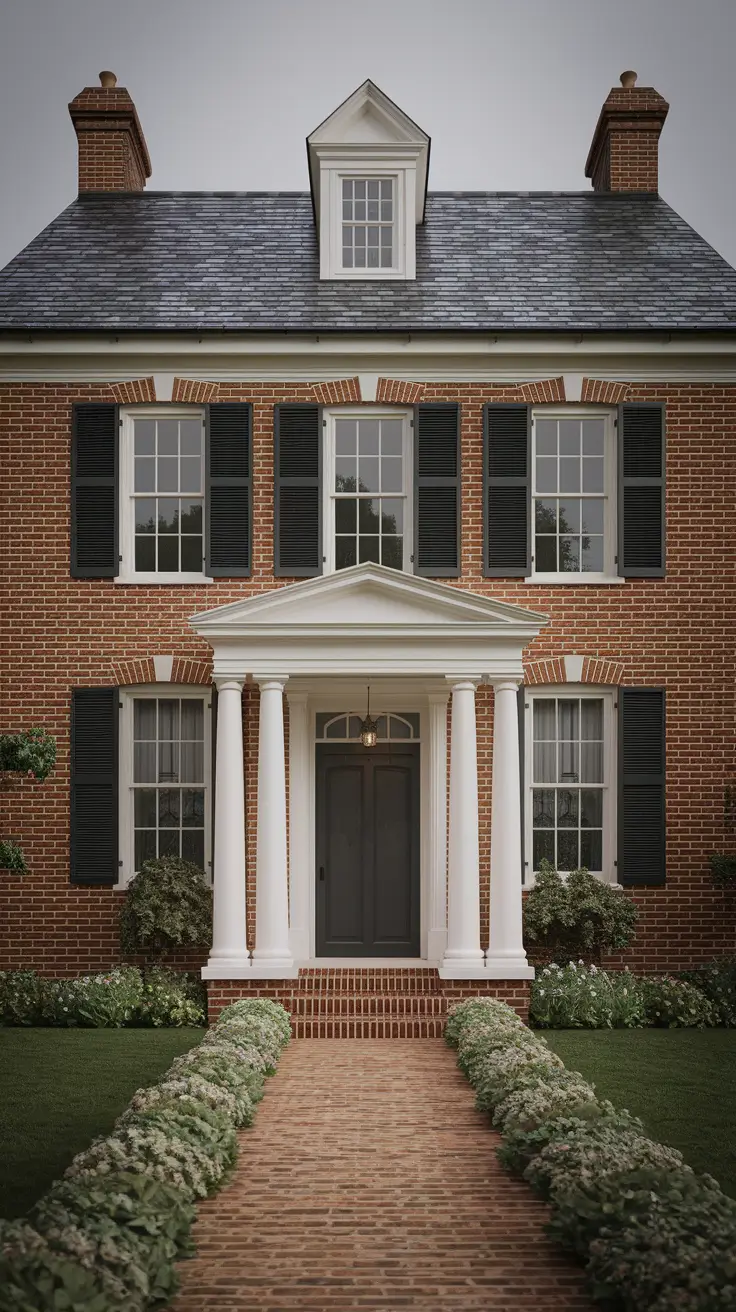
Sleek & Clean: Modern Exterior House Styles to Inspire
The reason exterior house styles modern are popular is easy to see—their clean lines, bold shapes and minimalism make them feel modern and current. Many of my clients have wanted something that is modern and still fits with the environment, so I’ve often used modern design. A lot of the time, you’ll notice that the roofs are flat or low, the siding is long and horizontal and there are strong color contrasts, for example, black window frames against white walls.
Key materials include steel, glass, and concrete. Large windows are often used to let in plenty of natural light and give residents great views, while using less artificial lighting. In my opinion, adding smart lights and custom cladding can give a home extra style and depth. Modern homes look great with ornamental grasses and gravel pathways in the yard.
I find that modern homes work well for people living in cities as well as those in the countryside. They offer the ideal space to express art by using shape and design. As Dwell Magazine points out, today’s modern homes use eco-friendly features like green roofs or solar panels and they still look stylish.
I’d also like to see this section cover entryway design and modern garage door styles, since they are both important parts of the home that can be adjusted to make the house look better from the street.
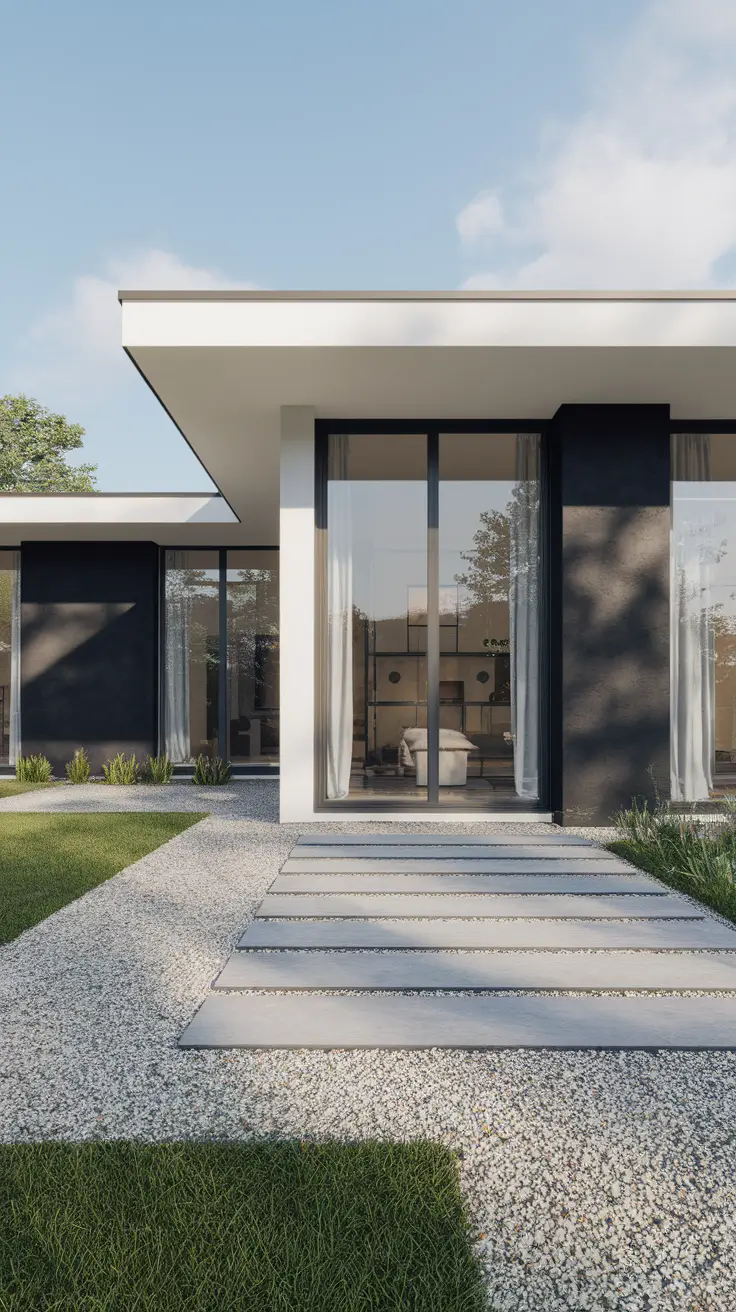
Farmhouse Charm: Timeless Exterior Styles with Rustic Roots
There’s something endlessly comforting about exterior house styles farmhouse. Usually, these homes combine classic and rustic designs with modern features. Many clients choose this style because it brings back memories and is ideal for families. High-pitched roofs, board-and-batten siding, and welcoming front porches are all part of this aesthetic’s DNA.
The outside of a farmhouse usually has natural wood, metal lighting and broad trim around both doors and windows. Many people choose black and white, as well as barn-style doors and matte hardware for their kitchens. Every aspect of the design helps to make this exterior farmhouse style look more real, while still feeling simple and not empty.
I have found that this style is most popular in the Midwest and Southern regions. According to Joanna Gaines from Magnolia Journal, a farmhouse can look both simple and stylish when you choose the right lighting, place windows well and landscape the property.
To complete this section, I’d include recommendations for complementary garden design—think lavender bushes, pea gravel walkways, and vintage-style planters—to tie the look together.

Sophisticated Simplicity: Contemporary House Exteriors
Today’s exterior house styles combine the latest trends with elements that are always in style. Although this category often matches modern designs, it lets you be more creative. When I’m designing a contemporary exterior, I look for asymmetry, mixed materials (like wood and stucco), and elements that feel artistic without being overly ornamental.
In recent times, many homes use metal roofs, cantilevered balconies and vertical cladding. Imagine cedar on the outside and black metal on the inside, along with big windows. You can design these homes with flexible floor plans, open fronts and long roofs. Its flexibility is what attracts homeowners who want their home to show their own style.
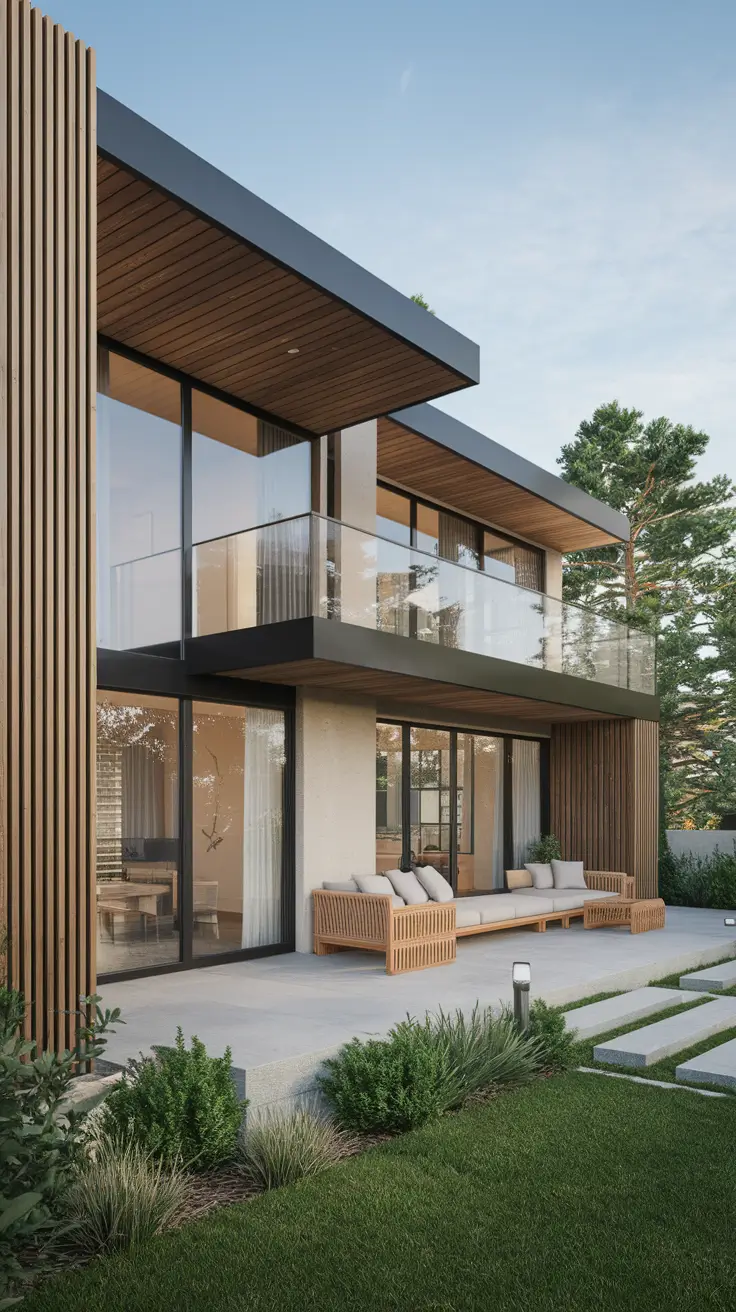
I believe these houses are perfect for areas that are transitioning or have just been developed, where it’s important to be unique. One project I worked on combined seating outside with vertical herb gardens, showing that you can design the exterior beyond the walls.
Missing from this discussion is a consideration of smart home technology applied to the outside—motion-activated lights, solar fencing and weather-adaptive paint would help this section stand out more.

Colonial Heritage: Refined Exterior Styles That Last
Colonial exterior house styles are some of the most recognizable in the country. What makes these homes special are their symmetrical design, brick walls and decorative crown moldings. I’ve made sure that the outside of my colonial homes is inspired by the 18th century, yet also uses modern and efficient materials.
Most often, you’ll see homes with multi-pane windows, entry doors in the middle and shutters that are either for decoration or for practical use. Grandness is created by columns and dormers and traditional red or Revere Pewter bricks make the house feel warm and distinguished. Lantern-style sconces and stone walkways complete the look.
My view is that this is a perfect look for communities with a rich history such as those found on the East Coast. Because colonial homes never go out of style, they often keep their worth. According to Zillow, many buyers looking for homes that last and represent the past are drawn to colonial homes.
I think adding a section on hip versus gabled roofs and their impact on the overall appearance would improve this section.
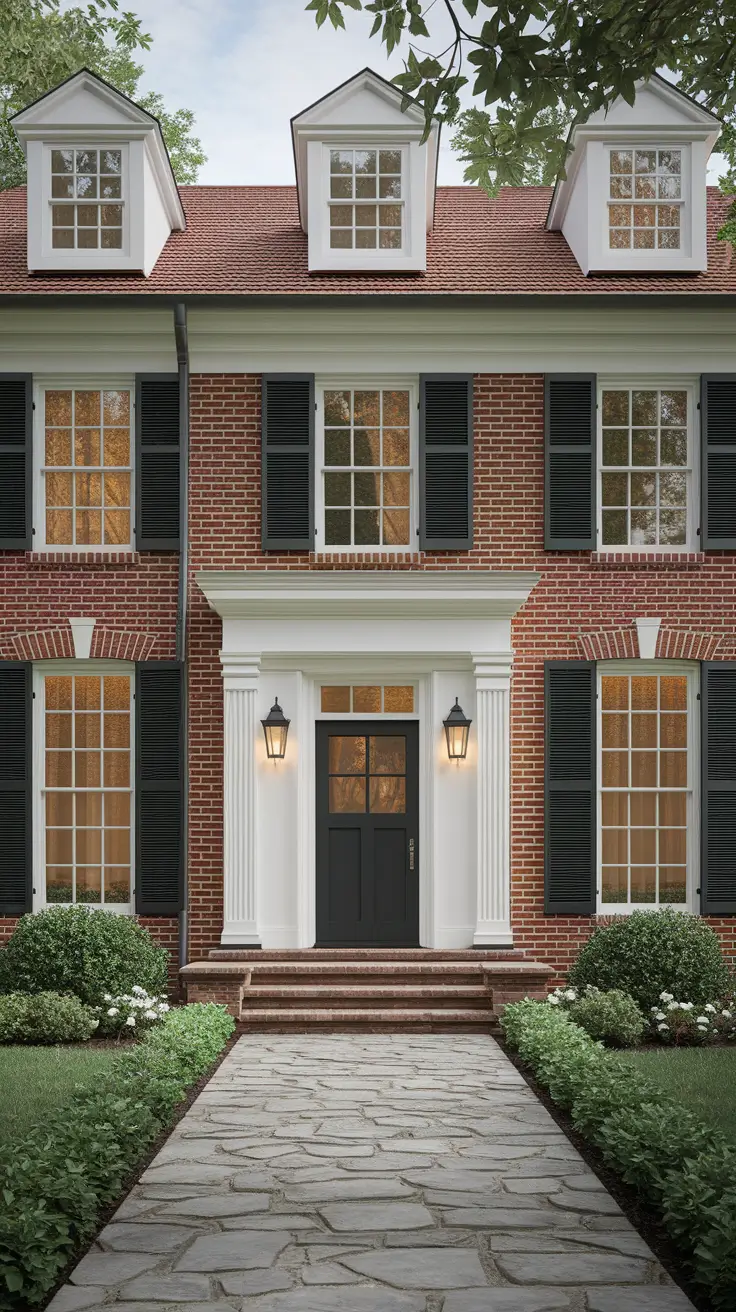
French Country Magic: Romantic Exterior Design Ideas
French country exteriors evoke romance, grace, and pastoral beauty. Many of these designs use stucco, natural stone and soft colors that remind us of lavender fields and the sky in Provence. I try to make a French country exterior feel calm and full of history.
Distinctive features of these buildings are arched windows, wrought iron balconies and clay tile roofs. The shutters are usually pastel or weathered wood and you’ll often find climbing ivy, neatly trimmed hedges and old water features in the landscaping. If you have furniture, it may be bistro sets or wrought iron benches placed along garden paths.
I believe this style is ideal for homes in the countryside or on vineyards. It includes a bit of decoration but doesn’t go overboard with it. Southern Living Magazine explains that mixing natural materials with warm light helps French country homes look comfortable and elegant at the same time.
We might add some tips for choosing antique exterior lanterns and vintage door hardware to make the look more old-world.

Windows to the Soul: Big Window Exterior House Styles
A current style in exterior house design is to create an open link between the home’s inside and outside areas. I enjoy working with clients to place large windows where they can enjoy both energy savings and a view of the entire landscape. The effect is simultaneously dramatic and grounding.
You’ll often find floor-to-ceiling glass, little framing and sometimes doors that slide or fold. Modern, contemporary and mid century homes look great with big windows because natural light is so important in their design. Many of them include custom blinds, extra overhangs or smart tinting options to control privacy and the temperature inside.

Whenever I’m working on large window projects, I always advise clients to use low-E glass. Architectural Digest believes this trend adds warmth to cold architecture and helps improve both mood and health by letting in more daylight.
Window framing materials such as aluminum, composite or thermally broken steel, should be discussed to complete the look with both style and practicality.

Warmth & Texture: Brick Exterior House Style Ideas
I’ve always valued the way brick house exterior styles look and feel, as a designer. They have a unique history and are very durable. Brick can look both simple and elegant and it helps exterior designs ground a house in a way that few other materials can. It looks great in traditional, colonial and farmhouse settings, depending on how it’s finished and arranged.
I’ve used both red clay brick and painted brick to achieve different looks in my designs. Using complementary materials such as wood shutters, wrought iron fixtures or copper gutters helps make your home more attractive. A white brick façade, painted to match brick ranch, results in a gentle, refined appearance that does not harm the home’s original design.
I think that how brick homes age is often overlooked. Natural materials gain character and patina as they age which synthetic materials can’t achieve. Better Homes & Gardens has found that brick homes tend to keep their value better than many other types of homes.
It would be good to cover lighting choices that fit well with brick—such as wall lanterns or up-lighting to draw attention to the brick’s natural features.

Breezy & Bright: House Exterior Styles for Florida Homes
Living and working near the coast has given me much knowledge about Florida house exterior design. Heat resistance, storm durability and a sunny coastal style are the main concerns when choosing materials. A lot of these houses feature stucco, metal roofs, light pastel colors and large front porches that allow for a breeze and a shaded place to rest.
A majority of the homes I have built in Florida have big overhangs, covered patios and strong hurricane windows to let homeowners see outside and stay safe. In this area, you’ll find many Mediterranean, coastal contemporary and pastel bungalow style homes. Lighter colors on the exterior help keep the house cool and tile or concrete roofs give the house character.

I think the real magic happens when you mix tropical plants with features that represent the area’s architecture. Coastal Living says that many Florida-style houses use both recycled wood and solar panels on their roofs.
I think it’s important to add information about adding outdoor kitchens or lanais to the design, as these are essential for life in Florida.

Stucco Statement: Elegant & Durable Exterior Styles
The exterior stucco used in different house styles often brings to mind Mediterranean or Southwestern styles, but lately, stucco has also become a main feature in modern and contemporary architecture. I have frequently applied it to the outside of buildings to show off their architectural design. Because it can withstand tough weather, it is perfect for use in coastal and dry areas.
Stucco looks wonderful with arched doorways, terra-cotta tile roofs and Revere Pewter or soft white colors. I usually add dark window frames and wrought iron light fixtures to the space. In current designs, smooth stucco goes nicely with metal railings and a simple garden.
I’ve noticed that homeowners appreciate the feel of stucco. When troweled, stucco looks lovely with its mix of light and shadow. Sunset Magazine believes stucco is easy to maintain and looks great with local plants.
This section would be stronger with recommendations for seasonal maintenance tips and modern stucco alternatives like EIFS (Exterior Insulation Finishing System) for energy-conscious homeowners.
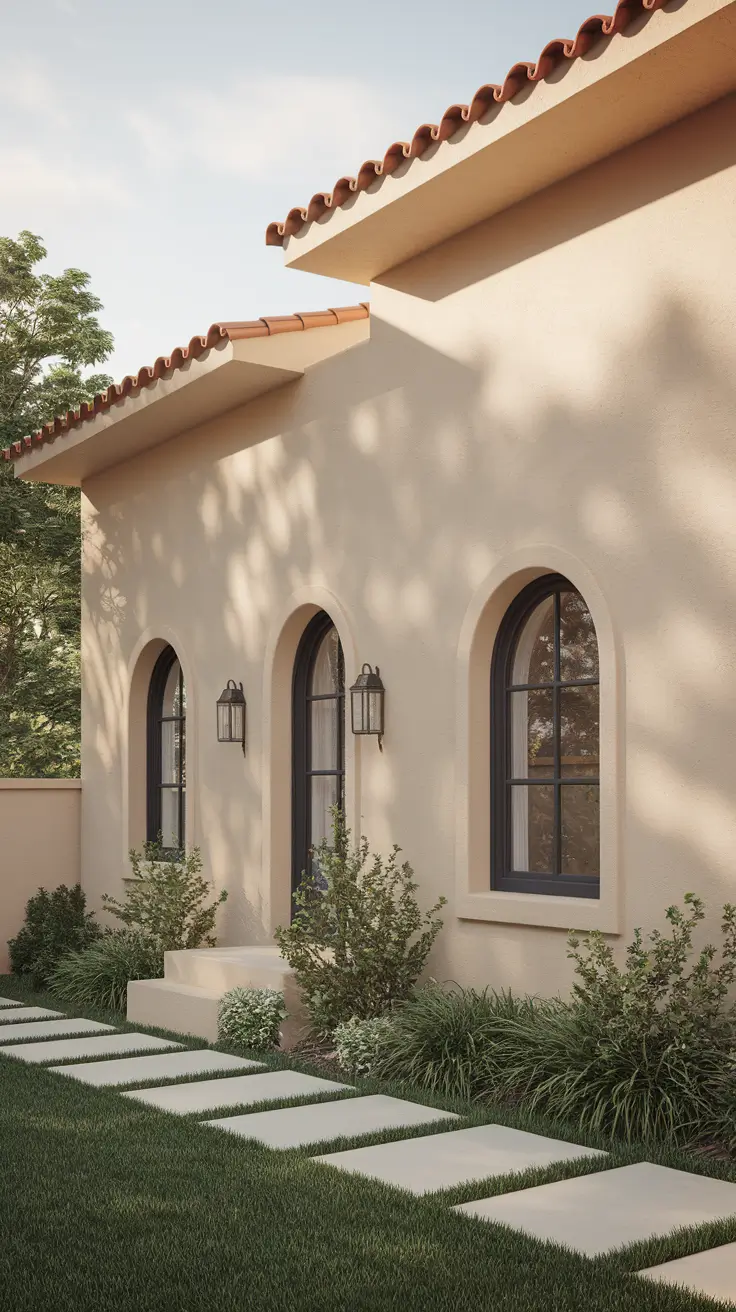
Traditional Uplighting: Elegant Lighting Ideas for Exterior Styles
Lighting is a detail that’s often missed in exterior house designs and choosing the right uplighting can really change the final look. I enjoy using lighting for more than safety; I also use it to highlight architectural parts such as cornices, columns and materials like stone or brick.
I often suggest using uplights for main features, path lights around walkways and downlights above front porches or overhangs. Choosing the right materials is important and bronze and black metal often look great with traditional and farmhouse designs. Solar-powered devices have seen great improvements and are now serious competitors for lasting performance.
I’ve noticed that adding uplighting can make a simple house look like it was featured in a magazine after dark. According to Houzz, adding lighting outside your home raises its value, makes it safer and allows you to use it after the sun goes down.
A weakness in this area is not discussing smart lighting with motion detection and color temperature control which are both attractive and useful.

Crisp & Calm: Revere Pewter for Stylish Home Exteriors
Revere Pewter by Benjamin Moore is a favorite shade of mine when painting the outside of homes. This shade of gray matches well with exterior house designs, from farmhouse to modern and acts as a neutral base that feels both welcoming and classy. I think it’s useful for homeowners who want a classic style but don’t want their home to look too plain or dark.
Using Revere Pewter with black window trims, stone walls or painted brick gives the space a rich and interesting look. Because it is so versatile, it looks great with greenery, metals and wood. It also shifts slightly as the day goes on, keeping the home’s curb appeal interesting.
I have found that homeowners are usually surprised to see how well Revere Pewter fits in with both coastal homes and suburban ranches. Elle Decor explains that the reason it’s so popular is because it links warm and cool neutral colors.
For this section to be complete, I’d mention that muted greens, soft golds and cream-toned whites are the best accent colors for Revere Pewter.

Color Stories: Choosing the Perfect Hues for Exterior Styles
Picking the right exterior color for your house can seem difficult, but it’s very important. I usually suggest to clients that the best way to use color outside is to either highlight or play off the features of their home’s architecture.
If your home is traditional or colonial, try using Revere Pewter, soft taupes or greige colors and for modern or contemporary homes, choose navy or charcoal. I prefer to use creamy whites or muted blues for brick house exteriors, as they help show the texture without creating a conflict. Earthy warmth is given to ranch homes by the colors sage green and dusty orange.
It’s my view that you should check colors in various lighting and weather situations. Sherwin-Williams and other paint companies allow you to see what the color will look like before you buy. HGTV says that the right exterior paint colors can make your home worth up to 10% more when you sell.
I’d also cover color theory here such as how color undertones affect what we see, as well as give examples of color palettes for various house styles.

Refined Ranch: Fresh Exterior Colors for Ranch Homes
If ranch homes are painted without attention to detail, they can seem dull, but with the right changes, they can look very stylish. Many ranch-style renovations I’ve done have shown that contrasting dark and light trim or siding can make the house look fresh.
In this area, painted brick, horizontal wood siding and composite panels are widely used. Muted green, taupe or terracotta colors look great and so do earth-tone color combinations. Brick ranch colors can be made more elegant and charming by painting them white and adding navy accents. I also enjoy putting metal furniture and pendant lights on front porches.
My house is a modern ranch and I’ve combined Revere Pewter and cedar trim which I think looks both personal and professional. Sunset Magazine has reported that the ranch revival is happening now, thanks to its open design and simplicity.
Including advice on landscaping here is helpful, since native grasses, succulents and stone pathways are the best choices for ranch homes.

Mid-Century Revival: Retro-Inspired Exterior House Styles
It’s not surprising that mid-century design is popular in exterior home styles again, since its neat shapes and connection to nature make it look both old and new. You’ll usually find low-slung roofs, straight lines and a minimalist style that still feels welcoming. I’ve done a number of projects where classic natural wood, high windows and carports are used in a way that feels modern.
I usually keep the look unbroken by using flat panel siding, whitewashed brick and warm cedar for trim or vertical accents. It’s important to use concrete and glass, but you should also include earthy colors in your design. Paired with butterfly roofs or long overhangs, this creates a silhouette that pays homage to the ’50s while looking distinctly current.
I’ve noticed that many homeowners enjoy that mid-century modern allows for flexible landscaping. There’s no need for lots of flowers; gravel beds, native grasses and cactus varieties work great instead. According to Dwell magazine, making your front door teal or orange is a popular way to bring a modern touch without losing the building’s character.
To elevate this section, I’d recommend including more energy-efficient upgrades, like integrated solar panels that don’t compromise the home’s streamlined profile. Highlighting the building’s horizontal design with smart exterior lighting would help the design.

Cozy Meets Class: English Country Exterior Home Designs
If you like the look of old-time architecture, English country homes feature stone, wood and gentle colors to create a very welcoming atmosphere. These houses seem to have stood the test of time, set among gardens or hedgerows and feature steep roofs, leaded windows and ivy covering the front. I have found that my designs work well when the homes are surrounded by nature and use unusual stones and stucco.
I use old-fashioned timber doors, wrought iron accessories and windows with several panes. Brick chimneys and shingles made from slate or shake give a home an old-fashioned look. I also choose pastel colors for shutters or muted greens for doors to avoid making everything the same.
I personally love these designs because they are both meaningful and remind me of a time when craftsmanship was most valued. According to House & Garden UK, adding handcrafted wood benches and vintage lanterns will finish off the style of these homes.
This area could use information about using thatched roofs and heated stones in colder climates to keep the design looking good and working well.

Porch Perfection: Front Porch Styles for Every Home Exterior
Porches are important in many exterior house designs because they link the inside with the outside. Wraparound and colonial stoops make a house look attractive and serve a purpose. I often point out that front porches help people connect and add value to a home’s design. In the South or Pacific Northwest, they’re useful all year long.
When it comes to design, a farmhouse porch usually has wooden railings, rocking chairs and matte black lanterns, while a modern porch uses sleek railings, clean tiles and planters built into the wall. What the materials are matters—treated wood, composite decking or patterned tile each have their own story to share.

I like to install fans or heaters in the right areas to make porches more comfortable all year round. I often echo Better Homes & Gardens’ tip: “Use the porch to express personal style,” whether that’s through seasonal wreaths or custom swings.
I’d expand this section by exploring more lighting options. Using traditional uplighting for your house’s exterior porch area can add drama and gently highlight architectural features when it’s dark.
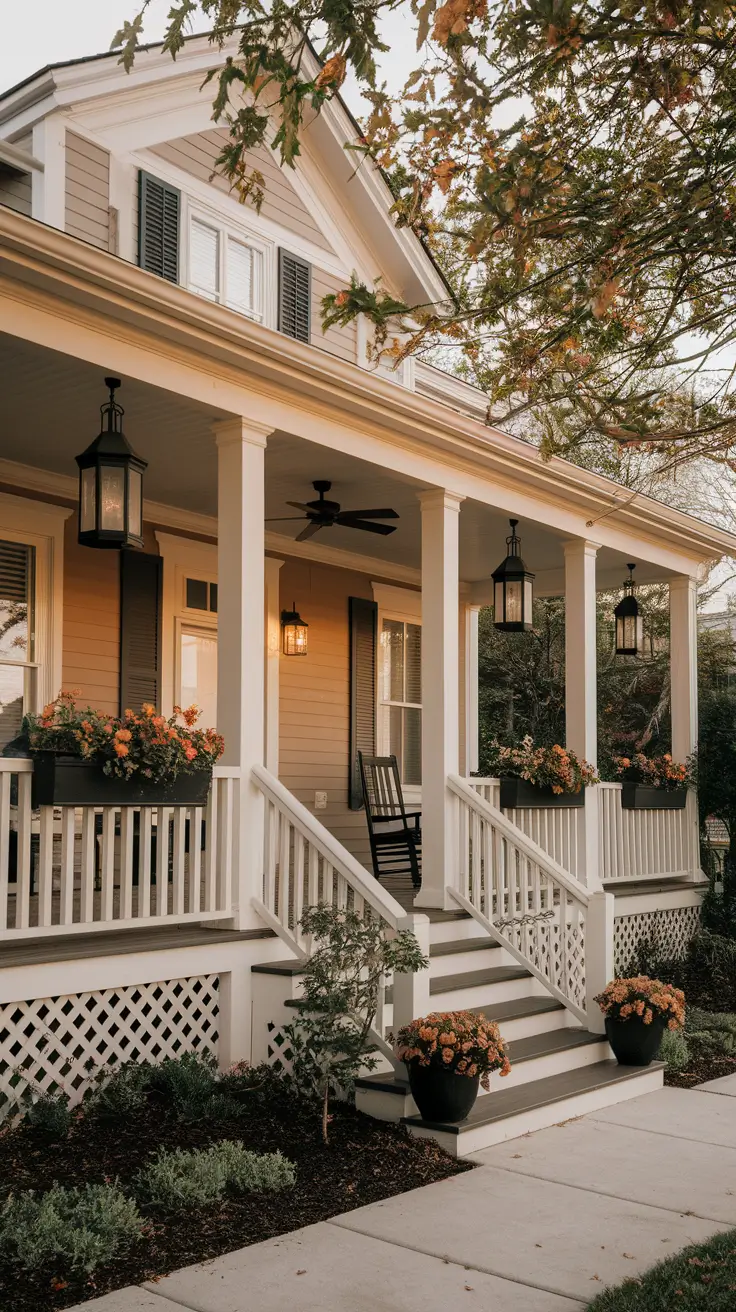
Nature-Inspired: Organic Exterior House Style Ideas
More and more, designers are blending the outdoors with the home, especially in environmentally friendly builds. I’ve made homes that have rammed earth walls, siding from reclaimed wood and green roofs, all of which match nature and help people live sustainably. The goal is to make the home fit well with its environment.
A great organic exterior for a home has uneven lines, includes plants native to the area and has big windows for plenty of natural light and views. Most of the time, I add stone paths, water features and earthy paint colors to help the property blend with its natural surroundings.
Clients often comment on how calming these homes feel. Architectural Digest says that adding biophilic elements such as trellises with climbing plants or mossy rock borders, can help reduce stress and improve your well-being.
A lot of these projects lack smart ways to handle water outside. I usually advise people to choose permeable pavers and rain gardens that match the design of their outdoor space.

Two-Tone Trends: Color Blocking Your Exterior Right
Using bold blocks of color on the outside of a house is not just a passing trend—it’s a strong statement. Having two or three contrasting hues on your walls, trim and roof helps highlight the design of your home. I’ve managed to achieve this look in both new and old homes with great results. It adds depth and dynamism without being overbearing.
A favorite combination is white and charcoal, navy and ivory and sage green with warm taupe. It’s best to pick a main neutral and use an accent color for features such as shutters, gables or porches. Carefully choosing color undertones ensures harmony.
Personally, I love how two-tone exteriors elevate basic structures. With the right furniture, a ranch house can look completely unique. Sherwin-Williams suggests using a satin finish on darker trims so you have contrast without having to deal with glare.
I’d like to add information on how light can change the way we see colors. Using daylight, porch lights or traditional uplighting can greatly change the look of a home’s exterior and homeowners should try out samples under different conditions.

Bold & Black: Dark Exterior Styles with Modern Flair
Black or dark gray exterior house styles are now more popular than ever. They are designed to be luxurious, minimal and edgy and look even better when combined with wood, steel or stone. Many clients have chosen this design for either city or forest homes, liking its strong appearance and the privacy it offers.
I usually mix matte black siding with vertical wood or concrete panels. When placed side by side, black-framed big windows make a strong design impact. Minimalist porches or flat roofs complete the effect.
Although these homes are stunning, I always remind clients that dark colors can make a room hotter. HGTV advises homeowners to match black exteriors with good insulation and windows that save energy. This keeps performance in line with aesthetics.
It would help to mention that dark paint often fades or shows dust more quickly. Recommend fade-resistant paint or cladding options designed for longevity.

White Wonder: Clean and Minimalist Exterior House Looks
While white homes are always appealing, they seem to stand out most in contemporary and farmhouse styles. For a simple and balanced style, I usually use white siding and add black or wood details. These homes feel clean, open, and highly photogenic.
If you want a farmhouse look, use vertical board and batten, for a modern home, smooth stucco and for traditional homes, paint the brick. Using white in your color scheme makes it simple for window trim, door frames and pergolas to pop out.
Many clients are amazed by the range of styles white exteriors can suit. Elle Decor explains that white is a great background for almost any accent such as navy shutters or brass lighting. It’s a safe yet impactful color.
I’d suggest adding soft landscape lighting for evening impact. A simple traditional uplighting method for your house exterior zones can make your white walls shine after the sun goes down.

Stone-Faced Elegance: Exterior House Styles with Stone Accents
Among the different exterior house styles, those with natural stone accents seem most permanent and impressive. I am drawn to using stone in my designs because of its interesting texture, deep color and traditional feel. Whether it’s a full stone façade or partial cladding, these exteriors blend well with both traditional and modern aesthetics, making them highly versatile and timeless.
I usually apply stacked stone veneers to entryways, chimneys or the lower walls of a home. They look wonderful when combined with stucco, timber beams or slate roofing. Neutral tones—beige, greige, charcoal—work best for long-term curb appeal. If you want a dramatic style, try teaming dark siding with lighter stone to create a balance of color.

I have found that clients really enjoy the touch and natural look of stone. According to Veranda, using stone, wood and soft landscaping together can help your veranda look like it was custom-made. Having natural materials in the home makes it more valuable to buyers.
I think this section could use some advice about how different seasons affect the durability of a product. Waterproofing the stone and using landscaping that drains well keeps it looking lovely for a long time.

Save Pin

